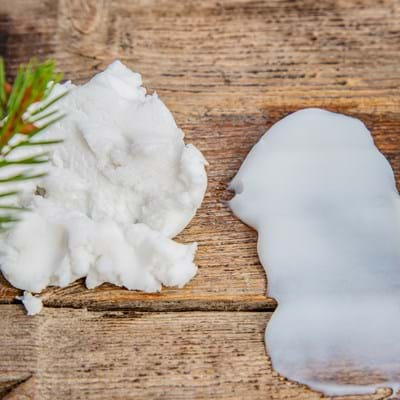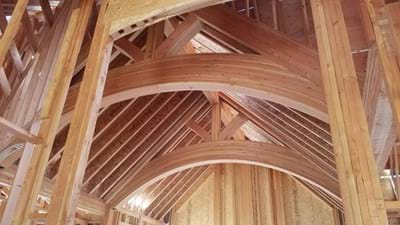Although adhesive bonding often represents only a tiny part of an EWP, it is often critical to the strength and reliability of the product. For glulam, bond or tensile strength measures the maximum force the board can withstand before it breaks.
Exilva® MFC improves the UF and MUF adhesive and hardener formulation and facilitates application onto the wooden substrates, increasing the bonds strength and ductility with high efficacy.
Table of contents
1. What are Engineered Wood Products (EWP)?
Engineered wood products (EWP) can be defined as the range of manufactured composite products processed for increased quality and capacity for the architecture, engineering and construction (AEC) industry.
For example, glue-laminated timber (glulam) is manufactured by bonding together layers of solid timber boards or laminations with structural adhesives. Each board runs parallel to the element's longitudinal axis. Before being glued together to form the cross-section desired, the boards are often finger-jointed, i.e., bonded in the lengthwise splice of continuous laminations. Glulam has a high strength-to-weight ratio, superior fire performance and corrosion resistance. Glulam elements are often used as load-bearing joists, beams and columns, and need to be tested and approved by official testing bodies.
A typical adhesive bond line in timber engineering has a thickness of 0.1-1mm. Although adhesive bonding often represents only a tiny part of an EWP, it is usually crucial for the product's strength and reliability.
2. Which adhesives are used for EWP?
Some of the predominant adhesives for EWP are formaldehyde based synthetic adhesives such as urea-formaldehyde (UF) and melamine-formaldehyde (MUF) resins. Melamine urea-formaldehyde (MUF) resins and adhesives produced by a condensation reaction between melamine, urea, and formaldehyde, possess better water resistance properties than UF. They are increasingly used in exterior applications that are more susceptible to moisture.
Moreover, the two-component thermosetting MUF adhesives create a colourless joint favourable to dark-coloured adhesives such as phenol-resorcinol (PR).
3. How are adhesive systems applied?
The two-component MUF adhesive systems require mixing adhesive base (resin) and hardener. A drawback of premixing the MUF glues before application is the short closed assembly time. However, in a new fast-setting process for glulam beam boards called "honeymoon", MUF is spread on the face of the first part, the acidic hardener is spread on the face of the second part and the two boards are assembled.
Furthermore, dosing systems with independent dosing lines for the adhesive and the curing agent are now available. Two individual nozzles for the adhesive and the curing agent are provided at different widths for separate application for the glulam production. The separate application system is highly effective, eliminates pot-life concerns and fulfils all the requirements of relevant adhesive specifications.
4. What are the unique Exilva properties, tailor-made for UF and MUF adhesive systems?
Exilva possesses a unique combination of robustness and rheological properties. It can control rheological properties by increasing the viscosity, shear-thinning and yield stress behaviour, thus improving storage stability and application properties.
The Exilva fibrils network is highly robust. It can withstand harsh conditions such as extreme pH 1-13, temperature and shear forces. These features make Exilva well suited for application in both UF and MUF adhesives and hardener systems.
Exilva can be added at the beginning of adhesive synthesis and is well-dispersed in highly concentrated formaldehyde solutions, subsequently used to synthesize UF and MUF resins.
It can also be added to the commercial adhesive post-synthesis. However, the amount of MFC added will be more limited since it will affect the adhesive's solids.
5. How can Exilva increase adhesive strength?
With addition of Exilva, the MUF adhesive will acquire a strong shear thinning behaviour enabling excellent sprayability, wetting and flow into board cavities securing thick bond lines, anti-sag and anti-spill. This results in improved adhesion and mixing of the resin adhesive and the hardener, which will influence the cured adhesive bond's mechanical properties.
Possessing a highly entangled network of cellulose fibrils and a large surface area covered with hydroxyl functional groups, Exilva allows for interaction between cellulose hydroxyl groups and resin methylol groups resulting in improvement of strength and ductility of the adhesive.
6. Are there other benefits besides improved performance and strength?
Improving performance and mechanical features allows reduction of formaldehyde resin, which will lower emissions contributing to a more eco-friendly and bio-based wood adhesive. With high efficacy, a low concentration of Exilva contributes to the adhesive and cohesive properties of the MUF resin. This allows for modification of the composition, for example, by reducing the melamine/urea ratio, the amount of formaldehyde or filler or the resin's synthesis time. In these cases, cost-effective adhesive formulation, application and handling of the adhesive system can be expected.




